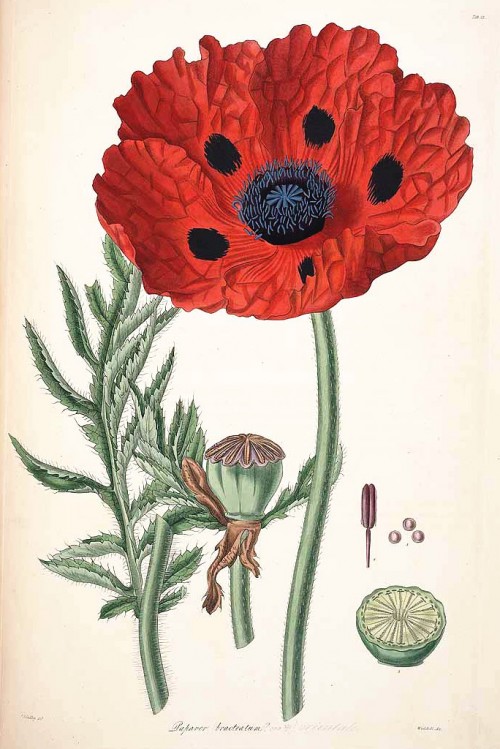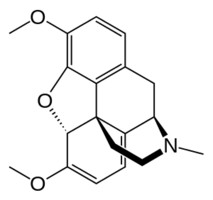Papaver bracteatum Lindl. - Papaveraceae - (great) scarlet poppy, Persian poppy, Arzneimohn, Armenischer Mohn
Perenniel herb, to 1m high, native to West Asia (Iran, Caucasus), cultivated for the production of thebaine and as ornamental; flowers (scarlet) red with black spot on each petal, calyx pubescent.
„Certain strains of P. bracteatum Lindl. are reported to contain in the roots significant quantities of thebaine, which can be used for the production of codeine and other opiates. Results from plants raised from Iranian seeds and grown near London for 4 to 5 years are presented. The botanical and chemical characters correspond closely to those of the active strain Halle III described by Böhm (1970) and enable this plant to be clearly distinguished from the closely related P. orientale L. The thebaine content of the roots was 0.25 % which is much lower than the value of 0.7 to 1.3% reported in Halle III roots. The fruiting tops, however, were also investigated and found to contain significant amounts of thebaine in field conditions. If tops were harvested in the summer and roots in the autumn, about 15 kg thebaine per hectare should be produced from our strain grown in the conditions described. This compares favourably with about 1 kg alkaloids per hectare from Turkish opium production or even the 3 kg per hectare from the high yielding Indian farms.“
[Papaver bracteatum Lindl. - a new plant source of opiates., Fairbairn, J.W., Hakim, F., Journal of Pharmacy and Pharmacology, Vol.25(5), 1973, 353-358]
„The known metabolic pathway for hydrophenanthrene alkaloids in Papaver somniferum has been examined for occurrence in P. bracteatum, a species reported to contain thebaine but no codeine or morphine… Studies of the natural abundance of morphinan alkaloids in P. bracteatum and the results from feeding codeinone-[16-3H] and codeine-[16-3H] indicate that this species can reduce codeinone to codeine but can not perform either of the demethylations to produce codeinone or morphine.“
[Morphinan alkaloids in Papaver bracteatum: Biosynthesis and fate., Hodges, C.C., Horn, J.S., Rapoport, H., Phytochemistry, Vol.16(12), 1977, 1939-1942]
„N-Methylthebainium (as iodide) and corytuberine were isolated from the roots and green aerial parts of Papaver bracteatum LINDL., thebaine race Halle III, as significant alkaloids in addition to the predominant alkaloid thebaine (0.61 and 0.23% respectively), as well as the minor alkaloids isothebaine, scoulerine, protopine, epialpinine (O-methylalpinigenine), N-methylisothebainium (as iodide), isoboldine, corydine, rhoeadine, magnoflorine, a mixture of coptisine and palmatine and a new alkaloid PB 1 C18H19NO4. Bracteoline and papaverrubines G, E, D and C were detected chromatographically. From the ripe capsules of the race Halle III N-methylthebainium (as perchlorate), corytuberine and a mixture of coptisine and palmatine were isolated in addition to thebaine (0.67%). From the ripe capsules of P. bracteatum, population Demavend (Iran), thebaine (0.56%), epialpinine, alpinigenine, corytuberine, N-methylthebainium (as iodide) and a mixture of coptisine and palmatine were isolated and the presence of papaverrubines G, D and C was detected. In the latex of flowering plants salutaridine was also detected.“
[Alkaloids from Papaver bracteatum LINDL., Slavík, J., Slavíková, L., Collection of Czechoslovak chemical communications, Vol.50(5), 1985, 1216-1226]

Lindley, J., Collectanea Botanica, t.23 (1821) [J. Lindley]
http://plantgenera.org/species.php?id_species=746755
